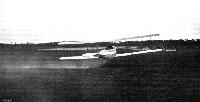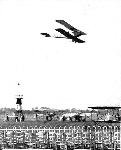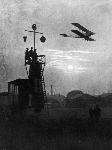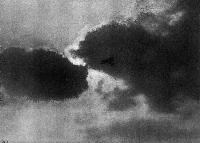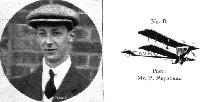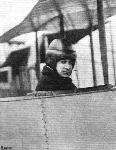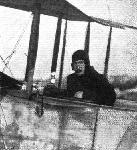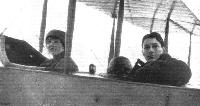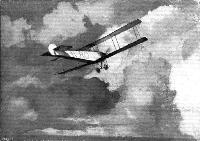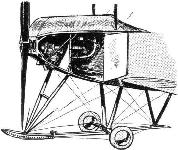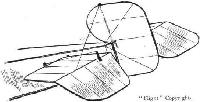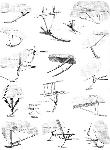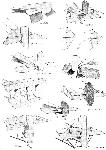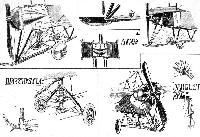A.Jackson Avro Aircraft since 1908 (Putnam)
Avro 500 (Type E)
<...>
Although he had created a remarkable aeroplane, A. V. Roe was not altogether satisfied. He therefore built an almost identical machine and fitted the 50 h.p. Gnome seven cylinder rotary taken from the superannuated Avro School Farman when it was dismantled in November 1911. The Gnome, only a fraction of the weight of other engines of similar power, gave the machine a much enhanced performance and during first flights at Brooklands by Parke on May 8, 1912 the machine reached 2,000 ft. in five minutes. The next day he flew 17 miles to Laffan's Plain in 20 minutes and completed all official trials the same afternoon. Officialdom was impressed and after some haggling over price, the War Office bought it and ordered two others with dual control. One of these is said to have been tested to destruction under ground load, but recent researches make it clear that the Avro 500 in question was merely proof loaded as part of the acceptance trials.
A. V. Roe always regarded the Gnome powered Type E as his first really successful aeroplane. Dismissing all previous machines as mere experiments he gave it the imposing type number 500, first of the Avro series which continues in use until the present day.
Wilfred Parke first flew the second Avro 500 at Brooklands on June 5, 1912 and delivered it to Farnborough in 23 minutes later in the day. Although so many Avro aircraft had first seen the light of day in Manchester, the inhabitants of that city had not at that time seen one in the air. To remedy this the third Army machine was 'borrowed' on June 28, taken from the factory to Eccles Cricket Ground and next day flown over Chorlton by Parke. Flights were made from Old Trafford over the Docks on the following day and from Fallowfield on July 5. After minor repairs the machine was then flown to Brooklands for normal flight test by Parke (with Gordon Bell as passenger) on July 19 before delivery by Raynham on July 22. The three Avro 500s joined the strength of the Central Flying School, Upavon, with serial numbers 404, 405 and 406. They were flown by pilots who later became famous, such as Maj. Brooke-Popham (later Air Chief Marshal Sir Robert Brooke-Popham, Governor of Kenya) and Lt.-Col. Cook R.A. who made a notable flight to Portsmouth in 404 on August 8, returning via Lee-on-Solent (50 miles) in 40 minutes on August 17. The Avro 500 rapidly established itself as the best available trainer, resulting in a further order for four two seaters in November 1912 and another for five single seaters to equip No. 3 Squadron, Netheravon, in January 1913.
Years of endeavour were being rewarded. To A. V. Roe fell the honour of escorting H.M. King George V round the second machine of the two seater batch at the Olympia Aero Show of February 14-22, 1913. With total orders at the dozen mark the firm had become sufficiently stable financially to re-form as a limited company on January 11, 1913 and to move into larger premises at Clifton Street, Miles Platting, Manchester in the following April. War Office orders were completed in June 1913 (the penultimate single seater was tested at Shoreham by F. P. Raynham on June 12) and later in the year six others were supplied to the Air Department of the Admiralty. These were stationed at Eastchurch, where the first, 41, was commissioned in August and the second, 51, passed its one hour acceptance tests on September 25, 1913. The pilot was Raynham with Lt. J. W. Seddon, Inspector of Naval Aircraft, as passenger. Deliveries ended with 750 in April 1914.
During the short Service life of the Avro 500, several important modifications were made. The prototype had no tail skid and depended on a steel shoe screwed to the bottom of the rudder. It was a weak arrangement and the rudder was redesigned to absorb landing shocks by sliding vertically up the kingpost against the action of a coiled spring. By mid-1913 this still somewhat hazardous system had been abandoned in favour of an ordinary bungee-sprung tail skid and the now-famous comma-shaped Avro rudder. Lateral control on all War Office single and two seat Avro 500s was by wing warping but modified outer wing panels incorporating inversely tapered ailerons on top and bottom wings were fitted later. At least 406 was further modified with constant chord ailerons, while in several instances the looped wing tip skids were replaced by braced bamboo rods with, or without, a small wheel at the tip.
A few Avro 500s remained in commission throughout the early years of the First World War and one was locally re-engined at Chingford with a 100 h.p. Gnome 14 cylinder rotary.
There were at least three other Avro 500s in addition to War Office and Admiralty machines. The first, of the sprung rudder type, was built for the Portuguese Government and paid for by public subscription. Despatched to Lisbon in September 1912 in charge of H. V. Roe, Copland Perry (pilot) and W. H. Sayers (engineer), it was unloaded on October 7 and conveyed by bullock cart to the flying ground at Belem. It was erected and flown on successive days, after which trial flights were made up the Tagus to Lisbon with the name "Republica" in large red letters on the fuselage and in green under the mainplanes. The machine was handed over to the Minister of War before 20,000 people on October 16 but the next day Perry just failed to reach the aerodrome when an exhaust valve on the Gnome jammed open. He put the Avro down gently in shallow water from which it was salvaged without damage, cleaned down, greased and stored for the winter.
The best known of all Avro 500s was probably that flown by F. P. Raynham to the Burton-on-Trent Meeting of August 2-5,1913 during which he carried numerous passengers and won the quick starting and cross country races. As if to underline the fact that this was no 'stick and string' freak, Raynham flew the machine south to Brooklands after the meeting and on August 9 raced it from scratch into second place in the six laps speed race at the Hendon August Meeting. Raynham then became so fully engaged in demonstrating the new Avro 504 prototype that the faithful 500 languished at Brooklands until he was free to give dual instruction to H. V. Roe and C. F. Lan-Davis. The latter bought the machine in December 1913 and gained his Aviator's Certificate on it on March 24, 1914. He first kept the machine at Brooklands but it was later based at Hendon where Lan-Davis fitted an elaborate array of instruments. He also attempted to mass balance the elevator by fitting broomsticks which projected forward at each end.
The other 'civil' Avro 500, delivered Brooklands-Hendon by F. P. Raynham on January 22, 1914 was used for display and instruction by J. Laurence Hall whose name appeared large on the fuselage. Two months later Hall succeeded in looping the machine to show that standard British aircraft were quite as manoeuvrable as the special lightweight French machines of the period. He flew hundreds of trouble-free hours in it and made numerous cross country flights including a 45 minute trip from Shoreham to Hendon with a lady passenger on July 14. An order for four Avro 500s by the Royal Aero Club was frustrated by the outbreak of the First World War but the Hall machine continued in instructional use at Hendon until commandeered by the War Office in September 1914. It remained in the same employ but carried serial 939 and in common with other surviving Avro 500s, was fitted with a twin skid undercarriage and oversize wheels.
SPECIFICATION AND DATA
Manufacturers: A. V. Roe and Company (reconstituted as A. V. Roe and Co. Ltd., 11.1.13), Brownsfield Mills, Great Ancoats Street, Manchester (moved to Clifton Street, Miles Platting, Manchester, 4.13); and at Shoreham Aerodrome, Sussex
Power Plants:
(Avro 500) One 50 h.p. Gnome
One 100 h.p. Gnome
Dimensions:
Span 36 ft. 0 in. Height 9 ft. 9 in.
Length
(Avro 500) 29 ft. 0 in.
Wing area 330 sq. ft.
Weights:
(Avro 500) Tare weight 900 lb. All-up weight 1,300 lb.
Performance:
(Avro 500)
Maximum speed 61 m.p.h.
Initial climb 440 ft./min.
Production:
Avro 500
Two seaters to War Office Contract May 1912 : 404 and 405 first flown at Brooklands 8.5.12 and 5.6.12 respectively, delivered to Farnborough 9.5.12 and 5.6.12, thence to C.F.S., Upavon; 406 first flown at Manchester 28.6.12, to Farnborough 22.7.12, thence to C.F.S., Upavon.
Two seaters to War Office Contract December 1912 : 430, 432, 433 and 448 to C.F.S., Upavon.
Single seaters to War Office Contract January 1913: 285 and 288-291 to No. 3 Squadron, Netheravon 1913, to Farnborough 1914.
Two seaters to Admiralty Contract 1913: 41 delivered to Eastchurch 8.13, crashed at Eastchurch 7.3.14; 51 to Eastchurch 25.9.13, later to Hendon, written off 11.8.15; 52 to Eastchurch 10.14, to Hendon 12.14, at Chingford 1916 with 100 h.p. Gnome; 53 at Eastchurch 1916; 94 no information; 150 to Eastchurch 4.14.
Other two seaters:
1. For the Portuguese Government, delivered at Lisbon 16.10.12
2. Demonstrator, first flown 7.13, sold to C. F. Lan-Davis 12.13, awaiting more powerful engine at Hendon 8.14 3. To J. L. Hall, Hendon 22.1.14, commandeered 9.14 and allotted R.F.C. serial 939
M.Goodall, A.Tagg British Aircraft before the Great War (Schiffer)
Deleted by request of (c)Schiffer Publishing
AVRO Type. E and Es (later known as Types 500 and 502)
<...>
A second machine of the type, but with a 50hp Gnome, was built and was flown by Parke at Brooklands on 8 May 1912. This proved to have a better performance and resulted in a early War Office order for three machines. The third of these was given its first flight from Eccles cricket ground near the Manchester factory. It was now also known as the Type 500. Further orders followed from the War Office, Admiralty, the Portuguese Government and civilian sources. It was during the time that these machines were in production that the company moved its Manchester premises in April 1913.
A number of changes were made to the aircraft during its operational life, including fitting ailerons to both top and bottom wings. The sprung rudder was replaced by a separate tail skid also various types of wing tip skids, some with wheels, were fitted. Later the rudder shape was changed to the more familiar comma shape of future Avro aircraft.
The War Office ordered a batch of five of the single-seater version, which were basically the same as the two-seaters and subject to the same modifications. These were identified as Type Es or Type 502.
Flight of 30 March 1912 and The Aeroplane of 11 April 1912 earned drawings and data for the prototype, with dimensions slightly at variance in some respects and neither agreed on the position of the radiators. The risk to the passenger was commented on by The Aeroplane. Flight showed auxiliary radiators just below the top wing, probably fitted later and the cause of Sayers' entrapment.
Type E (Avro Type 500)
Power: 50hp Gnome seven-cylinder air-cooled rotary driving a 9ft diameter propeller.
Data
Span 36ft
Weight 900lb
Weight allup 1,300lb
Length 29ft
Area 335 sq ft
Max speed 62 mph
Production: Eighteen aircraft of various versions.
Type E 1 Prototype. First flight 14 March 1912 at Brooklands. Destroyed at Shoreham 29 June 1913.
Type E (Avro 500) seven machines delivered between May 1912 - April 1913 to the War Office. Serial Nos.404-406, 430, 432-433, 448 used at CFS Upavon.
Two machines delivered May 1913 and February 1914 to Admiralty contract, serial Nos.41 and 150 used at Hendon and Eastchurch.
One machine to Portuguese Government delivered Lisbon October 1912 named Republica.
One machine first flight July 1913 to private owner at Hendon later with RNAS serial No.939.
One machine to Hall School at Hendon January 1914, later with the RFC serial No.491.
Type Es (Avro 502) 5 machines delivered between April-June 1913. to War Office contract. Serial Nos.285, 288-291.
P.Lewis British Aircraft 1809-1914 (Putnam)
Avro E 500
<...>
Three more 500s were built to a War Office order and were fitted with 50 h.p. Gnomes, the fuselage floors embodying celluloid panels for observation during cross-country flying. The first was delivered to Farnborough from Brooklands on 9th May, 1912, by Lt. Parke and was exhibited on the ground during an inspection of the Military Wing of the R.F.C. by H.M. King George V. Two of the three R.F.C. 500s were fitted with larger rudders than were considered to be necessary by both Roe and Parke, while the third retained its original tail.
Later in the year a fourth Gnome-engined 500 was bought by Portugal out of the Portuguese National Fund, and was handed over on 16th October, receiving the name Republica. The following day the machine experienced engine failure while being demonstrated by Copland Perry, and landed in the River Tagus. The R.F.C. were so satisfied with their acquisition that four more 500s were ordered in December, 1912, and another five in January, 1913, after the formation of the private limited company of A. V. Roe. The 7.5 aspect-ratio, unstaggered two-bay wings had their original warping control replaced on later versions by constant-chord, and also by inversely-tapered, ailerons.
An improved model was displayed at the 1913 Olympia Aero Show, with the Gnome fully enclosed. The Avro Flying School at Shoreham took the E.N.V.-engined prototype on to its strength, but, on 29th June, 1913, it crashed with fatal results to the solo pupil-pilot, Richard N. Wright. Other Gnome-powered 500s were supplied to L. Davis of Forest Hill and J. L, Hall, and Humphrey Verdon-Roe was taught to fly on one at Brooklands by F. P. Raynham at the end of 1913. In addition to being used by No. 3 Squadron, R.F.C., the 500 was employed for training at the C.F.S. and by the R.N.A.S., Chingford.
SPECIFICATION
Description: Two-seat tractor biplane. Wooden structure, fabric covered.
Manufacturers: A. V. Roe & Co., Brownsfield Mills, Manchester.
Power Plant: 50 h.p. Gnome, 40 h.p. Viale.
Dimensions: (Gnome) Span, 36 ft. Length, 29 ft. Wing area, 330 sq. ft.
Weights: (Gnome) Empty, 900 lb. Loaded, 1,360 lb.
Performance: Maximum speed, 61 m.p.h. Climb, 440 ft./min. Endurance, 2-5 hrs.
Price: ?950.
J.Bruce British Aeroplanes 1914-1918 (Putnam)
Avro 500
ALTHOUGH the part played by the Avro 500 in the 1914-18 war was a small one, it was an aeroplane of historical importance for it was one of the first machines to be ordered for the use of the British Army. The order was placed by the Government early in 1912, and was for three two-seat biplanes fitted with 50 h.p. Gnome engines.
Before the Gnome-powered Avros appeared, A. V. Roe completed a two-seat biplane with 60 h.p. E.N.V. engine, and this aircraft provided the basis for the military type. The Avro biplane with the Gnome engine was originally known as the Avro Biplane Type E, but some time later it was given the first of a new series of Avro type numbers which has continued until the present day. To quote Sir Alliott Verdon-Roe, as “a piece of drawing-office swank” the type number 500 was chosen as the beginning of the series.
The Avro 500 bore quite a strong resemblance to its E.N.V.-powered predecessor. It was an equal-span two-bay biplane with warping wings, and was of wooden construction. The undercarriage, like that of the biplane with the E.N.V. engine, was an unusual structure which recalled the arrangement on contemporary Nieuport monoplanes. The wheels were mounted on the ends of a transverse leaf spring which was attached to a sturdy central skid. There was no tailskid; instead, the machine rested on the bottom of the rudder, which was suitably shod. This arrangement was obviously a somewhat dangerous one, and a modified rudder was later fitted. The new rudder still acted as tailskid, but had a certain amount of vertical travel against the compression of a coil spring in order to provide a measure of shock absorption.
The first of the Avro 500s was in service in May, 1912, and when the Central Flying School of the R.F.C. was opened at Upavon on August 17 th of that year its equipment included two Avro 500s. Several of these Avro biplanes were used at the C.F.S., and the type was used in both the Naval and Military Wings of the early R.F.C. The original order was increased to twelve machines, and the contract enabled the firm of A. V. Roe & Co. to be soundly established.
A late refinement was the fitting of a comma-shaped rudder similar to that of the later Avro 504. This rudder was fitted with a proper tailskid. The shape of the skids below the wing-tips varied: some Avro 500s had half-hoops; others had simple braced skids which, in some cases, were fitted with two tiny wheels.
A single-seat version of the type also existed. It had a slightly longer decking on top of the nose portion of the fuselage. It may have been this version of the design which was known to the R.F.C. as the Avro Type Es.
The Avro 500 was also built for several private owners, and one at least had inversely tapered ailerons in place of wing-warping. It was owned by J. L. Hall.
By the time of the outbreak of hostilities in 1914 only a few Avro 500s survived, and they were used for training purposes. Perhaps the last was the one which survived at Chingford until August nth, 1915, when it was wrecked. This machine was fitted with a 100 h.p. Gnome fourteen-cylinder two-row rotary engine, an installation which was probably “home-made”.
SPECIFICATION
Manufacturers: A. V. Roe & Co., Brownsfield Mills, Manchester.
Power: 50 h.p. Gnome. At least one installation of a 100 h.p. Gnome was made.
Dimensions: Span: 36 ft. Length: 29 ft. Airscrew diameter: 9 ft.
Areas: Wings: 335 sq ft.
Weights; Empty: 900 lb. Loaded: 1,300 lb.
Performance: Maximum speed: 62 m.p.h.
Service Use: Flown by No. 3 Squadron R.F.C. and at the Central Flying School before the war. Was used as a trainer in the early months of the war; e.g. at Chingford.
Serial Numbers: 41, 51-53, 94, 150, 285, 288-291, 404-406, 430, 432, 433, 448.
O.Thetford British Naval Aircraft since 1912 (Putnam)
AVRO 500 (TYPE E)
Two-seater used for training by both the Naval and Military Wings of the RFC from 1912. Used by RNAS flying school at Chingford after outbreak of war in 1914. Naval Wing allotted Nos.41, 51 to 53, 94, and 150. One 50 hp Gnome engine and loaded weight of 1.300 lb. Maximum speed, 62 mph. Span, 36 ft. Length, 29 ft.
Jane's All The World Aircraft 1913
AVRO. Aeroplanes. A.V. Roe & Co., Clifton Street, Miles Platting, Manchester; also Shoreham, Sussex. A.V. Roe designed his first machine, a biplane, in 1906. It was the first British machine to leave the ground. He then experimented with triplanes in Lea Marshes, where he managed to fly with only 9 h.p. in 1908-9. In August, 1
910, built Roe III, and in September, Roe IV, also triplanes (see 1911 edition for full details). In 1911 he abandoned triplanes for the Avro biplane. School: Shoreham.
D 1911-12. E 1912. F 1912. G 1912-13. E 1912-13.
Model. 2-seater 2-seater Totally Totally Hydro-biplane.
biplane. biplane. enclosed enclosed
mono. biplane.
Length.....feet(m.) 31 (9.45) 29 (8.84) 23 (7) 29 (8.84) 33 (10)
Span.......feet(m.) 31 (9.45) 30 (11) 28 (8.50) 36 (11) 47-1/2 (14.50)
Area....sq.ft.(m^2.) 279 (26) 335 (32) 158 (14-1/2) 335 (32) 478 (34-1/2)
Weight, empty lbs.(kgs.) 800 (363) 900 (482) 550 (249) 1191 (540) 1740 (789)
Weight, fully loaded, lbs. (kgs.) ... 1300 (589) 800 (363) 1700 (771) 2700 (1224)
Motor...........h.p. 35, any 50 Gnome 40 Viale 60 Green 100 Gnome
make
Speed....m.p.h. (km.) 48 (78) 61 (97) 65 (105) 61.8 (100) 55 (90)
Number built
during 1912....... several 6 1 1 1
Remarks.--Of the above, 4 of the 50 Gnome E type were purchased by the British Royal Flying Corps, and one by the Portuguese Government; the other went to Windermere on January, 1913, for hydro experiments. Climbing speed of this type is 440 feet per min. (134 m.) Dual control fitted. D type are no longer being built. Climbing speed of F type, 300 feet per min. (91.5 m.) Gliding angle, 1 in 6. G has a gliding angle 1 in 6.5. On October 24th, 1912, made British record to date, 7'31-1/2" (=450 miles). The hydro. was delivered to the British R.F.C. naval wing early in 1913.
Журнал Flight
Flight, February 8, 1913.
WHAT THERE WILL BE TO SEE AT OLYMPIA.
THE MACHINES.
Messrs. A. V. Roe and Co., Ltd.,
Will be exhibiting on their stand one of the 50-h.p. Gnome-engined passenger-carrying biplanes that have given the War Office such satisfaction. It is interesting to recall, too, that a similar machine was recently supplied to the Portuguese Republic. Light, but strongly-constructed, fast, able to carry weight well, the 50-h.p. Avro biplane has proved itself one of the most successful machines of the day. And it reflects great credit on its designer, Mr. A. V. Roe who, having tasted the bitter sweetness of the pioneer, has gone doggedly ahead to such success. Mr. Roe has the distinction of being the only constructor, we believe, in the world who has designed and constructed successful monoplanes, biplanes, and triplanes.
Flight, February 15, 1913.
A. V. ROE AND CO., LTD.
They are exhibiting a 50-h.p. Avro biplane, fitted with a Gnome engine, and arranged to carry a passenger. Similar machines to the one shown have been supplied in numbers to the Royal Flying Corps, and we have heard that they are extremely popular mounts with those pilots who fly them. Back in last October, too, one of these machines was delivered to the Portuguese Republic, it having been bought by public subscription. Perhaps our readers, or at any rate those of them who follow the progress of things fairly closely, will recall that the first machine of this type to leave the Avro works was supplied to Mr. J. Duigan as far back as in the September of 1911. It is thus quite an old design, but that is not to say that it is old-fashioned - it is as much up-to-date to-day as any machine we could mention.
The body of the biplane is an ordinary form of built-up box girder covered with fabric to preserve its lines, and to permit of it travelling through the air with as little disturbance as possible. In front, under a metal cowl, is mounted the 50-h.p. Gnome motor, swung between double bearings and turning a 10 ft. Avro propeller at the rate of 1,200 r.p.m. As our sketch shows, inspection doors are fitted in the side of the body so that the motor may be readily accessible when it requires adjustment. The passenger is seated some distance behind the motor, and his seat is so low down in the body that only the upper part of his head projects through the well-padded cockpit well. Thus he is protected to a great extent from the propeller draught. The pilot is equally as comfortably installed in his cockpit behind and what he is not able to see over the side of the machine, he can obtain a sight of by looking through a window let into the floor between his feet.
The landing gear resembles, to a great extent, that originated by Nieuport, used on Nieuport monoplanes. There are a few improvements, however, among them being that the laminated cross-springs are assembled to the wheel hubs in a rather more satisfactory way than is employed on the Nieuport. Mr. A. V. Roe, too, has introduced, on this machine, a clever form of skid toe, which, instead of being rigid, can adapt itself to any shock caused by striking an obstacle. Its general details can be seen from the sketch we publish.
The planes. - Span 36 ft., and have a chord measurement or 4 ft. 9 ins. Having a high aspect ratio, they are, as may be supposed, very efficient. Their cross-section has a Phillip-type entry, while it has the peculiarity that the under-surface of that part of the section to the rear of the rear-spar is level in normal horizontal flight. Twelve spruce struts separate the planes, and the bracing is entrusted to stranded-steel cable of generous cross section. The planes warp for the correction of lateral balance.
The tail is formed by a flat surface rectangular in plan, at the back of which are hinged two elevator flaps of a total area of 12 square feet. The rudder is novel, in that it is arranged to slide vertically up the rudder bar, against the compression of a coil spring. It is armoured on the underside by a steel shoe, and this is made to serve the double purpose of rudder and tail skid. The average speed of this Avro biplane may be taken as being 65 m.p.h.
Flight, September 20, 1913.
THE AERIAL DERBY.
PILOTS AND HOW TO RECOGNISE THE MACHINES.
No. 8. The Avro Biplane
is of the tractor type with the engine in front. The fuselage, or body, is covered in throughout its entire length. The main planes have a very pronounced dihedral angle.
THE MACHINES, WITH SOME DETAILS.
No. 8. The Avro biplane, fitted with an 80 h.p. Gnome engine, is similar to the usual Avro type, except that the planes are slightly staggered, and that there are minor modifications in the landing chassis. The span of both upper and lower planes is 36 ft.
It is a tractor biplane, and, as is to be expected from the length of experience of its designer and constructor, Mr. A. V. Roe, it is a fast machine, very stable, and thoroughly reliable.
Flight, July 24, 1914.
SHOREHAM TO HENDON.
SOME IMPRESSIONS OF A NON-STOP FLIGHT.
By MISS M. LOUISE ELLIOTT.
VISITORS to Hendon are accustomed to seeing a little tractor biplane slip out from a group of sheds at the far end of the enclosures, lift and climb steadily in ever-widening circuits, until it becomes an infinitesimal speck which vanishes above the clouds. Suddenly a silver spark flashes out from a space of blue sky, like a new and brilliant evening star - the tractor screw, flashing in the sunlight as the machine turns and commences its descent. It comes back, circles the aerodrome again and again, floating slowly round and downwards with propeller stopped, and, after a perfect landing, finally comes to rest by its own shed.
Possibly the megaphone man has announced the name of the pilot and machine, but if he has not it is of no consequence. "Good wine needs no bush," and Mr. Laurence Hall's flying of the Avro announces itself.
I have done a good deal of passenger flying at Hendon, on different types of aeroplanes, and with some of the best pilots of the day. There is no need to make any odious comparisons, but it may safely be said that the steadiness, controllability, and general comfortableness, if one may put it in that informal way, of the little 50 h.p. Avro make it a delightful machine to fly in, and that anyone who has made even a single flight with Mr. Hall can have nothing but supreme confidence in his ability as a pilot.
Moreover, aerodrome flying is all very well, but the "out and home" variety is better, and a genuine cross-country flight over a fair distance is real aviation, or should be. So altogether, when I found myself, in company with several keenly interested friends, at the very successful inaugural week-end meeting at the Shoreham Aerodrome, and knew that I was to have the privilege of accompanying Mr. Hall on his return flight to Hendon, I felt pleased with myself and all the world.
Shoreham has many of the qualities of the ideal aerodrome - even service, open surroundings, boundaries guiltless of trees, and excellent atmospheric conditions. One of my most delightful recollections will always be a long flight I had with Mr. Hall on the Sunday afternoon. We went out round the country and over the sea, and the sea, beautiful as it always is, never looks so beautiful or so wonderful as from an aeroplane; and my friends told me afterwards that when the machine disappeared through and above the clouds for a time, the excitement among the crowd was intense.
We were to make the return flight on either Monday afternoon or Tuesday morning, according to circumstances, but on Monday the wind was so high that it would have been unwise to start, until too late to reach Hendon by daylight, so Mr. Hall, with sound north-country common sense, utilised the interval in having the machine thoroughly overhauled and tested. One reason for the successful record of the hard-worked little Avro is the fact that it is always kept in the most perfect flying condition, and in this respect it is an object-lesson to many bigger and more ambitious machines. As luck would have it, more things went wrong on that Monday evening than during the preceding six months, but they were all successfully negotiated, from a broken tail-skid to a missing petrol funnel.
Tuesday morning dawned bright and clear, and very soon after the appointed time we were off. We started with two or three typical wide circuits, the Avro climbing, beautifully; but the wind was up early too, and just at first we were badly bumped about - upwards, downwards, first on one side and then the other. The bumps did not worry me in the least, for we steadied again instantly after each one of them, and they really only showed how perfectly the pilot had the machine in hand. I sat and watched the blue sea, veiled by a tender haze towards the horizon, and edged by a white thread of breakers against the stone-coloured beach; the red-and-white toy bungalows grew smaller every moment, and at something over 2,000 ft. the wind grew steady, and we turned and shot inland, still climbing at a terrific pace.
We were very soon well over 4,000 ft., and going across what, to me, was unknown country, with no resemblance to what one sees when travelling to or from Brighton in the ordinary way. Once or twice we saw in the distance a dark patch, which developed into the streets of a town, and fled away behind us. Here and there a dark line marked a railway, a white one a road; a patch of greenish-blue meant water. So we went on through the fresh clear air of the summer morning, high above the dusty, weary world, with everything except ourselves - and when I say "ourselves" I count the Avro as one - unsubstantial as the fabric of a vision. Filmy wreaths of cloud played hide-and-seek with us, or flung their shadows on the dim green fields lying infinitely far below, with the hedges seeming to run into one another as they raced past beneath us. On either side of me our wings stretched out, creamy-golden, the stay-wires flashed in the sunshine like silver; before, the engine sang rejoicingly, and behind, unseen but unfaltering, were the watchful eye and steady hand on which our fates depended.
It was with a positive crash of disappointment that I heard a voice behind me say "Brooklands!" and saw the great motor track, looking like a miniature model, far down beneath us, for, with our low-powered engine, we had expected to take perhaps an hour in getting to Brooklands, and had arranged, therefore, to land there on our way. And now we seemed to have only fairly started, we were going splendidly, and the idea of stopping was most distasteful. To my joy, we did not descend. We had done the greater part of our journey, and had a good half of our resources still in hand. To have turned into the high wind for the sake of making an unnecessary landing would have been sheer waste of time and trouble, and so we left Brooklands behind us and raced ahead.
Just after this, the machine surprised me by wavering a little once or twice, for the first time since we left Shoreham - it had been as steady as a rock ever since. I put it down to the state of the air, which was quite different as we neared the Thames, but Mr. Hall explained afterwards that when we started he had the compass set for Brooklands, and after passing there had been busy resetting it for Hendon, with altered course and wind accordingly. Over the river and beyond it, the wind was very tricky, and there were patches of haze and cloud everywhere; London itself lay under a thick blanket of black smoke. Only a few minutes after crossing the Thames I recognised the Welsh Harp, and then, in no time at all, microscopically tiny and with colours dulled by the mist, the red-white-and-blue pylons of the London Aerodrome.
The song of the engine ceased, the propeller slackened, stopped; and slowly, gently, we floated round the whole extent of the aerodrome for perhaps a couple of circuits. I know of nothing so indescribably fascinating as this particular feat, and Mr. Hall executes it to perfection, but it cannot be done on every machine, nor should it be attempted by any but a thoroughly capable and resourceful aviator, as the sequel shows. Whether the spirits of the air at Hendon were annoyed at having been neglected, even for a week-end, I cannot say, but apparently they withdrew their support from us, for we suddenly and quite simply fell down. I had always wanted to know what this particular experience felt like, and now I do, but I had barely time to realise it properly at the moment. The voice behind me said "Remou!" the nose of the machine went down in a nearly vertical dive, the propeller spun round again, and in far less time than it takes to tell we were on our way in a normal attitude, and at full flying speed. It was a magnificent "save" at the end of an altogether fine piece of flying. I would not have missed it for the world, and my one regret was that there were not more people there to see it.
After that, anything else would have been an anticlimax, so we came down, landing so beautifully that it was impossible to tell when we touched the ground. We made our way to the telephone office, and I addressed the inevitable stack of picture postcards, while Mr. Hall rang up Shoreham to announce our safe arrival. I knew we had done well, but the real fun of the thing only struck me when he got through to his mechanics, who had just settled down to a well deserved breakfast, and found it at first difficult to convince them that we had really reached Hendon. They did not give us credit for getting even so far as Brooklands, and thought we must have come down somewhere en route!
Well, it was not surprising, for we had done the whole journey, from one shed to the other, in forty-five minutes. It may not be a record, but for a little machine like the 50 h.p. Avro, handicapped by carrying a passenger, it was a first-class piece of work. At any rate, I know one person will never forget it - and that is the passenger.
Flight, January 8, 1915.
MILESTONES.
<...>
Then followed, in 1912, a very similar biplane in which, however, the body had been made considerably wider, thus giving more elbow room for the occupants, but otherwise following the practice of the previous model. This type was fitted with a 50 h.p. Gnome engine, and a great number of the 50 h.p. type were sold to the Government and proved very successful.
<...>
Flight, October 29, 1915.
CONSTRUCTIONAL DETAILS.-VIII.
<...>
In the double skid type of chassis illustrated in our last issue the suspension is generally fairly simple, since it is possible to sling the wheel axle by means of strands of rubber from the two skids. When a single, central skid is employed it is no longer possible to solve the problem of elastic suspension quite so simply. There are, however, two or three alternative ways of providing the necessary flexibility. One of these is to make the axle itself flexible. This is generally obtained either by building up the axle in the form of a transverse laminated steel spring which carries on its extremities the two wheels, or by mounting the wheels on two short stub axles, which are then in turn connected at their outer ends to a transverse spring mounted immediately above the axles. In one of the accompanying pages of illustrations will be found two examples of the transverse laminated spring axle. One is the French Nieuport monoplane, and the other the older type Avro biplane. These two undercarriages are similar in type, but differ somewhat in detail. The construction will, we think, be clear from the sketches without needing any explanation, except that in both cases the chassis struts are streamline steel tubes. In the Nieuport the central skid is a steel tube, whereas in the Avro this member is made of ash.
<...>
















